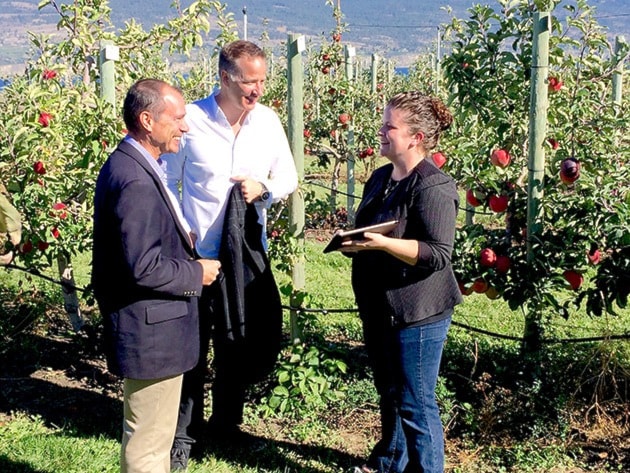The changing climate in the Okanagan has broad implications for agricultural pest control, including increasing populations of problem species, and the arrival of new pests in the region.
But a recently initiated project – adapting a successful pest management decision support tool developed by Washington State University – will provide Okanagan tree fruit growers with an important new resource to improve orchard management.
Washington State University’s Decision Aid System (DAS) is a web-based platform designed to transfer time-sensitive information on pest management to orchardists, using real-time, local weather data and scientific pest and disease management information to help predict and manage pests and diseases.
“This is the Cadillac of pest management decision support systems: tried, tested, and loved by Washington growers because it saves them time and money and improves the efficacy of pest management,” says Melissa Tesche, Acting General Manager for the Okanagan-Kootenay Sterile Insect Release Program. “The benefits to the Okanagan will extend beyond the growers—being more precise with chemical applications helps to maintain beneficial insect populations, reduces environmental impacts, and makes life even more pleasant for the communities bordering the orchards.”
DAS was designed to be used by growers and has a clear, simple on-line interface that provides information linking weather conditions with pest lifecycles and treatment information and alerts. It is programmed for conventional and organic management recommendations, allowing growers to choose the treatments that are right for their operation. The system has been in used in Washington State for nearly a decade, and is highly valued by Washington growers.
“Bringing Washington State University’s Decision Aid System to the Okanagan would not be possible without the cooperation of each of the project partners: Summerland Research and Development Centre, The BC Fruit Growers’ Association, BC Tree Fruits and Grower’s Supply, the BC Ministry of Agriculture, the Sterile Insect Release Program, and of course, the support of the BC Climate Action Initiative,” says Tesche.
Developing resources to link weather, pest and disease data with decision support tools was identified as a priority action under the Okanagan Regional Adaptation Strategy released earlier this summer by the BC Agriculture and Food Climate Action Initiative. The regional strategy brought agricultural producers together with local governments and provincial agencies to identify collaborative solutions and actions to adapt to the climate change impacts identified for the Okanagan.
Funding to adapt the Decision Aid System to the Okanagan is part of a $300,000 investment in the implementation of the Okanagan Regional Adaptation Strategy by the federal and provincial governments through Growing Forward 2, a federal-provincial-territorial initiative. Climate adaptation programming reflects the BC Ministry of Agriculture’s ongoing commitment to climate change adaptation in the agriculture sector, while enhancing sustainability, growth, and competitiveness. These investments help achieve the federal government's goal to encourage the agriculture and agri-food sector’s leadership in job creation and innovation.
The BC Agriculture and Food Climate Action Initiative was established by the BC Agriculture Council in 2008, and is led by an advisory committee of agricultural producers, food processors and representatives from various government agencies. The Initiative has been supported by the Investment Agriculture Foundation of BC with funding provided by Agriculture and Agri-Food Canada and the BC Ministry of Agriculture through Growing Forward 2.
